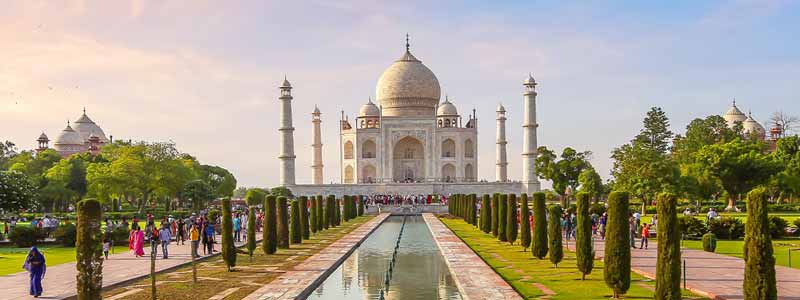Top 8 Facts About the Taj Mahal, located in Agra, India, is a magnificent white marble mausoleum commissioned by Mughal Emperor Shah Jahan in memory of his beloved wife Mumtaz Mahal. Completed in 1653, it stands as a symbol of eternal love and is renowned for its stunning architectural beauty, blending elements of Islamic, Persian, Ottoman Turkish, and Indian styles.
The Taj Mahal’s central dome rises 240 feet, flanked by four smaller domes and four slender minarets at each corner. The exterior is adorned with intricate carvings, inlaid gemstones, and calligraphy of Quranic verses. The surrounding gardens, designed in the Persian style, feature reflecting pools and lush greenery, enhancing the monument’s serene and majestic ambiance.
Inside, the cenotaphs of Shah Jahan and Mumtaz Mahal are enclosed by an octagonal marble screen inlaid with precious stones. The actual tombs are located in a lower chamber, beneath the main hall.
Designated a UNESCO World Heritage Site in 1983, the Taj Mahal attracts millions of visitors annually and remains one of the most iconic and celebrated structures in the world, epitomizing the zenith of Mughal architecture and artistry, Top 8 Facts About the Taj Mahal.

The Taj Mahal was created by Emperor Shah Jahan for his favorite wife Mumtaz Mahal.
Shah Jahan was the fifth Mughal emperor and ruled from 1628 to 1658. When his third and favorite wife, Mumtaz Mahal — a princess of Persian nobility and also Agra native — died, Shah Jahan was so overcome with grief that he wanted to build the Taj Mahal as a testament of his undying love for her.
There are several other mausoleums outside the Taj, but in the same complex, where Shah Jahan’s other wives and favorite servants are buried, showing a level of respect and thoughtfulness to them too.
There is a legend that Shah Jahan wanted to build a black marble Taj for himself.
The Black Taj, also known as the Kaala Taj or Second Taj, is a legendary black marble mausoleum that is said to have been planned to be built across the Yamuna River directly opposite the Taj Mahal.
Shah Jahan is said to have planned to build this black marble mausoleum as a tomb for himself and wanted the two structures (the Black Taj and the Taj he built for Mumtaz Mahal) to be connected by a bridge.
Historians still disagree about the validity of this claim, although the people of Agra whose families have lived there since Mughal times have continued to pass down the legend of the Black Taj to this day. Many people believe that evidence of the Black Taj cannot be found by archeologists because the son of Shah Jahan, who overthrew and imprisoned him, had it torn down, Top 8 Facts About the Taj Mahal.
It took 20 years and 20,000 workers to build
The Taj Mahal is built of red sandstone and covered in large plates of marble. The artisans who helped in the construction of this world wonder hailed from many different countries and regions, including Central Asia, Iran, Syria, and Turkey. It took them 20 years to complete this momentous project and over 20,000 artisans were involved, Top 8 Facts About the Taj Mahal.
The rumor that Shah Jahan had the artisans hands cut-off to ensure they could never replicate such a feat ever again remains nothing more than a myth, as no proof to support this claim exists.
It appears that the workers were not only paid well but also respected for their skills that were necessary to build the Taj Mahal.
1,000 elephants were used to transport the building materials to Agra.
The materials needed to build the Taj Mahal were transported with the help of over 1,000 elephants. It was mainly white marble and the red sandstone that required transportation, and it was sourced from all over India and the Middle East.
Red sandstone is common in Persian architecture and can be seen in other Mughal structures like the Red Fort and Jama Masjid both in Delhi, while white marble was used as a representation of the divine.
The Taj Mahal’s color changes constantly throughout the day.
The shimmering white marble used in the construction of the Taj Mahal changes color according to the time of day — from the uplifting yellow of sunrise to the desolate deep blue of night. People have imagined poetically that the color changes reflect the feelings the late emperor underwent during his time with Mumtaz Mahal and after her death. Find out the best times to visit the Taj Mahal.
The Taj Mahal cost today’s equivalent of 1 billion USD!
This huge and luxurious architectural gem in total cost over INR 32 million in 1653 — US$1 billion in value today! That was a spend of about US$1 million a week for its 20 years of construction. So, you can appreciate that Shah Jahan almost spent all of the Mughal Empire’s funds building the Taj for his favorite wife.
The Taj Mahal might be slowly sinking into the Yamuna River.
Sitting aside the Yamuna River, the foundations of the Taj are supported by wood. It is thought that the wood can retain its strength only when it’s kept wet. However, as per the latest statistics, the Yamuna River is slowly drying up. People are worried that the decrease in water might threaten the Taj.
The Rooms with the Tombs Are Not Adorned or Decorated – Top 8 Facts About the Taj Mahal
Islamic scriptures forbid any inscriptions and decorations on the tomb. That is why despite the exuberant exteriors of the Taj Mahal, the actual room in which the tombs of Mumtaz and Shah Jahan now rest is devoid of any stucco work in the walls, Top 8 Facts About the Taj Mahal.
